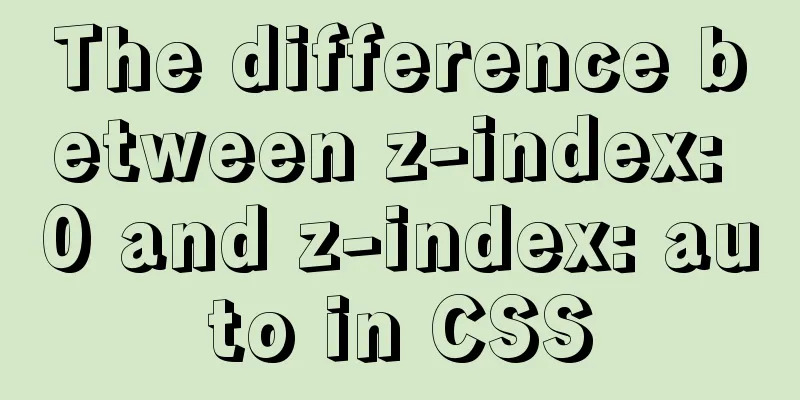MySQL index leftmost principle example code

|
Preface I was recently reading about MySQL indexes. When I saw the combined index, I found a leftmost principle. I studied it in depth by searching for relevant information. Let's take a look at the detailed introduction. Create a table CREATE TABLE `user` ( `id` int(10) unsigned NOT NULL AUTO_INCREMENT, `name` varchar(10) DEFAULT NULL, `sex` tinyint(1) DEFAULT NULL, `age` tinyint(2) DEFAULT NULL, PRIMARY KEY (`id`), KEY `Index_user` (`name`,`age`) USING BTREE ) ENGINE=InnoDB AUTO_INCREMENT=4 DEFAULT CHARSET=utf8mb4; Test SQL The first mysql> explain SELECT * FROM `user` where name="tom" \G *************************** 1. row *************************** id: 1 select_type: SIMPLE table: user partitions: NULL type: ref possible_keys: Index_user key: Index_user key_len: 43 ref: const rows: 1 filtered: 100.00 Extra: NULL The second mysql> explain SELECT * FROM `user` where age=18 and name="tom" \G *************************** 1. row *************************** id: 1 select_type: SIMPLE table: user partitions: NULL type: ref possible_keys: Index_user key: Index_user key_len: 45 ref: const,const rows: 1 filtered: 100.00 Extra: NULL The third mysql> explain SELECT * FROM `user` where age=18 \G *************************** 1. row *************************** id: 1 select_type: SIMPLE table: user partitions: NULL type: ALL possible_keys: NULL key: NULL key_len: NULL ref: NULL rows: 3 filtered: 33.33 Extra: Using where 1 row in set, 1 warning (0.00 sec) The fourth mysql> explain SELECT * FROM `user` where name="tom" and age=18 \G *************************** 1. row *************************** id: 1 select_type: SIMPLE table: user partitions: NULL type: ref possible_keys: Index_user key: Index_user key_len: 45 ref: const,const rows: 1 filtered: 100.00 Extra: NULL 1 row in set, 1 warning (0.00 sec) Summarize It can be seen from this that only queries in which the where clause of SQL contains the first field of the joint index can hit the index. This is called the leftmost matching feature of the index. The use of joint indexes has nothing to do with the order in which the where conditions are written. MySQL query analysis will be optimized and the index will be used. However, to reduce the pressure on the query analyzer, it is best to be consistent with the left-to-right order of the index. The data items of the b+ tree are composite data structures. For example, when (name, age, sex) is used, the b+ tree builds the search tree in order from left to right. For example, when data such as (Zhang San, 20, F) is retrieved, the b+ tree will first compare the name to determine the next search direction. If the names are the same, the age and sex will be compared in turn to finally get the retrieved data. However, when data such as (20, F) without a name is found, the b+ tree does not know which node to check in the first step, because the name is the first comparison factor when the search tree is established. It is necessary to search based on the name first to know where to query next. Well, that’s all for this article. I hope the content of this article will be of certain reference value to your study or work. Thank you for your support of 123WORDPRESS.COM. You may also be interested in:
|
>>: Element tree control integrates a drop-down menu with icons (tree+dropdown+input)
Recommend
【Web Design】Share E-WebTemplates exquisite foreign web page templates (FLASH+PSD source file+HTML)
They are all web page templates from the foreign ...
React Hooks Detailed Explanation
Table of contents What are hooks? Class Component...
WeChat applet canvas implements signature function
In the WeChat applet project, the development mod...
Vue+el-table realizes merging cells
This article example shares the specific code of ...
MySQL quickly inserts 100 million test data
Table of contents 1. Create a table 1.1 Create te...
Solution to the problem of repeated pop-up of Element's Message pop-up window
Table of contents 1. Use 2. Solve the problem of ...
CSS implements 0.5px lines to solve mobile compatibility issues (recommended)
【content】: 1. Use background-image gradient style...
MySQL slow query method and example
1. Introduction By enabling the slow query log, M...
Copy the contents of one file to the end of another file in linux
Problem description: For example, the content of ...
Common shell script commands and related knowledge under Linux
Table of contents 1. Some points to remember 1. V...
Vue+Openlayer batch setting flash point implementation code (based on postrender mechanism)
Effect picture: Implementation code: <template...
Three ways to communicate between Docker containers
We all know that Docker containers are isolated f...
Linux uses NetworkManager to randomly generate your MAC address
Nowadays, whether you are on the sofa at home or ...
Detailed explanation of overflow-scrolling to solve scrolling lag problem
Preface If you use the overflow: scroll attribute...
VUE+SpringBoot implements paging function
This article mainly introduces how to implement a...









